Start your Persian chain weave by gathering 18-gauge aluminum rings with a 1/4 inch diameter and specialized pliers. Close four rings and arrange them in a 2-2-2 configuration, positioning the top two rings over the bottom two for proper alignment. Insert two open rings through the closed rings on each side to establish the interlocking pattern. Maintain consistent tension throughout the weaving process and check alignment regularly to prevent twisting or gaps. Master these foundational techniques to reveal advanced variations and professional finishing methods.
Materials and Tools Required for Persian Chain Weaving
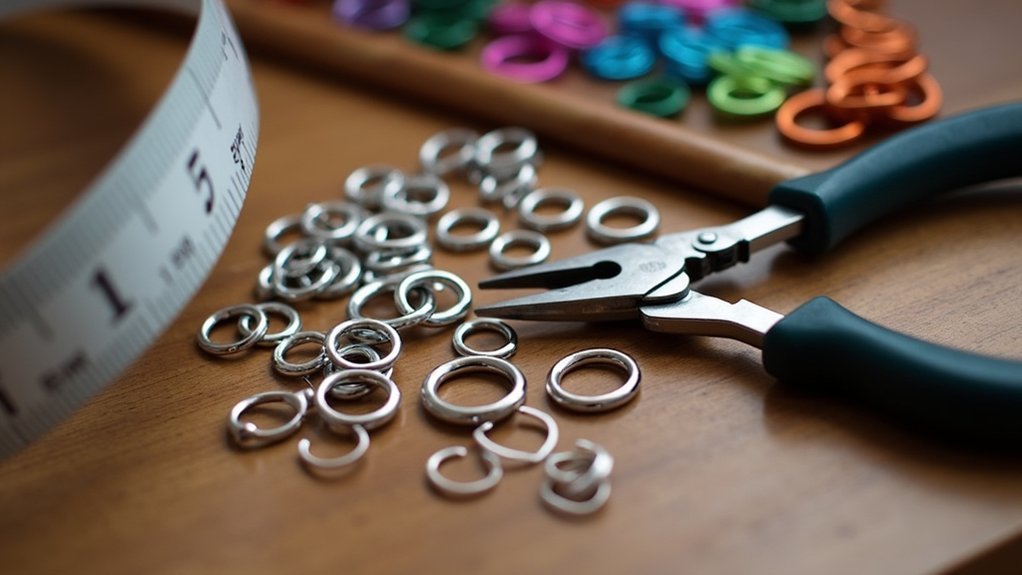
Before you plunge into creating stunning Persian chain weave jewelry, you’ll need to gather the right materials and tools.
Start with bright aluminum rings, typically 18-gauge at 1/4 inch diameter, which serve as your primary building blocks. Consider adding contrasting bronze rings for visual interest and design flair.
Choose bright aluminum rings in 18-gauge, 1/4 inch diameter as your foundation, with bronze rings for striking contrast.
Essential tools include specialized pliers designed for opening and closing rings efficiently. You’ll also need a sturdy work surface to keep everything organized during your project.
While optional, a jig can help manage rings more effectively, especially for beginners learning the technique.
Safety should be your priority—wear protective gloves to prevent hand injuries from metal rings.
Keep wire ties nearby to secure rings during assembly, ensuring smoother weaving sessions.
Understanding Ring Specifications and Aspect Ratios
You’ll need to master ring specifications and aspect ratios to create a successful Full Persian weave that’s both flexible and visually appealing.
Your aspect ratio must reach at least 5.0 to guarantee proper drape and weaving ease, though you can go higher for enhanced appearance.
Let’s examine the ideal AR requirements, wire gauge selections, and ring size compatibility to help you choose the right materials for your project.
Optimal Aspect Ratio Requirements
Five critical factors determine whether your Full Persian chainmail will achieve its characteristic drape and flexibility, but none matters more than selecting rings with the proper aspect ratio.
You’ll need a suitable aspect ratio of 5 or higher for your Full Persian weave to function correctly. While you might consider using rings with a high 4.x AR, this approach isn’t recommended as it compromises the weave’s structural integrity.
Your wire sizes should include 22awg, 20awg, 18swg, or 16swg to maintain proper proportions. These correspond to 0.6mm through 1.6mm wire diameters with inner diameters ranging from 3mm to 8mm.
Attaining the correct AR guarantees your chainmail maintains its distinctive appearance while providing the flexibility that makes Full Persian weaves so appealing for both functional and decorative applications.
Wire Gauge Material Selection
Material choice considerably impacts your Full Persian chainmail’s performance, with aluminum rings offering the perfect starting point for most crafters.
You’ll want aluminum rings because they’re lightweight and easy to manipulate during weaving. Bronze rings provide excellent contrast options and develop beautiful patina over time, making them perfect for decorative pieces.
For wire gauge and inner diameter combinations, choose 22 gauge with 1/8 inch inner diameter, 20 awg with 3/16 inch, 18 swg with 1/4 inch, or 16 swg with 5/16 inch.
These specifications guarantee proper aspect ratios above 5.0 for maximum weave integrity.
Consistent ring sizing maintains uniform tension throughout your project. Mixed materials create visual interest, but stick with similar gauges to preserve structural consistency and weaving ease.
Ring Size Compatibility Chart
Several critical measurements determine whether your rings will create a successful Full Persian weave, with aspect ratio serving as the most important compatibility factor.
You’ll need an AR of 5 or higher for ideal results, though high 4.x ratios can work with reduced performance.
The most effective ring sizes pair specific wire sizes with corresponding inner diameter measurements.
Choose 22awg wire with 1/8 inch ID, 20awg with 3/16 inch ID, 18swg with 1/4 inch ID, or 16swg with 5/16 inch ID.
In metric terms, use 0.6mm wire with 3mm ID, 0.8mm with 4.8mm ID, 1.2mm with 6.4mm ID, or 1.6mm with 8mm ID.
These proven combinations guarantee proper flexibility while maintaining structural integrity throughout your chainmail project.
Setting Up Your Workspace for Chainmail Construction
You’ll need to establish a proper workspace before starting your Persian chain weave project.
Start by gathering your essential tools and materials, then organize them systematically to streamline your workflow.
Don’t forget to set up proper safety equipment to protect yourself during the construction process.
Essential Tools and Materials
Five critical components form the foundation of any successful Persian chain weave project, and having them properly organized before you begin will dramatically improve your crafting experience.
Your essential tools and materials directly impact both safety and quality outcomes.
Here’s what you’ll need:
- Rings – Metal or plastic with an aspect ratio of 5 or higher for ideal flexibility
- Pliers – Chainmail-specific pliers that won’t damage rings during opening and closing
- Safety gear – Protective gloves to prevent cuts from sharp-edged rings
- Organizational aids – Jigs for ring management and sorted containers for easy access
You’ll find that investing in quality tools upfront saves time and frustration later.
Proper preparation guarantees smooth weaving and professional results.
Workspace Organization Techniques
While proper tools are essential, your workspace organization can make or break your Persian chain weaving experience. Start by designating a flat, clutter-free surface where you’ll construct your chainmail. This foundation prevents rings from rolling away and minimizes distractions during complex weaving sequences.
| Organization Element | Purpose | Best Practice |
|---|---|---|
| Small containers | Ring separation | Sort by size/color |
| Pliers placement | Easy access | Within arm’s reach |
| Lighting setup | Enhanced visibility | Bright, direct light |
Use small containers or trays to separate different ring sizes and colors, keeping them easily accessible. Position your pliers within arm’s reach and guarantee proper lighting illuminates your work area. Consider wearing safety gloves to protect against sharp ring edges, creating a comfortable working environment for extended weaving sessions.
Safety Equipment Setup
Although workspace organization forms the foundation of successful chainmail construction, implementing proper safety measures protects you from the inherent risks of working with metal rings and sharp tools.
Your safety equipment setup requires careful attention to prevent injuries during extended weaving sessions.
Essential safety equipment includes:
- Safety glasses – Wear protective eyewear to shield your eyes from ring snaps and metal debris that can occur during construction.
- Ergonomic pliers – Select tools with rubber grips to reduce hand fatigue and maintain comfortable control throughout your project.
- First aid kit – Keep medical supplies within reach, as metal rings can cause cuts or scrapes during handling.
- Protected work surface – Use silicone mats to catch dropped rings and prevent workspace damage.
Creating the Initial Ring Foundation
Four closed rings form the cornerstone of your Full Persian weave, and getting this foundation right will determine your chain’s success. You’ll arrange these foundation rings in a 2-2-2 configuration, ensuring they’re positioned for easy access during subsequent steps. Maintain consistent tension while handling these closed rings to keep your base stable and supportive.
| Step | Ring Type | Position | Action |
|---|---|---|---|
| 1 | Closed | Base layer | Arrange 2-2-2 |
| 2 | Closed | Middle pairs | Prepare access points |
| 3 | Open | Through middle | Insert 2 rings |
| 4 | All rings | Foundation | Check stability |
Next, you’ll insert two open rings through the middle pairs of your closed rings. Position them correctly to prepare for the weave’s continuation. This initial foundation determines your chainmail’s overall integrity and appearance.
Mastering the Basic Persian Weave Pattern
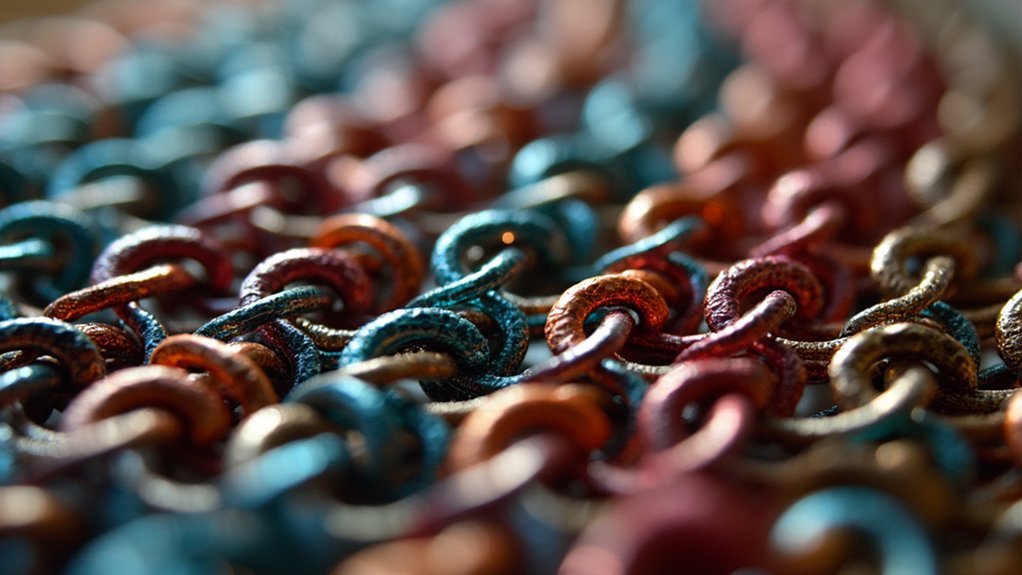
You’ll need to prepare your rings systematically before attempting the Full Persian pattern, separating pre-opened rings from closed ones to streamline your workflow.
Start building your foundation by arranging four closed rings in the essential 2x2x2 chain formation, which creates the structural base for the intricate six-ring links that define this weave.
Master consistent tension control throughout the process, as uneven pressure will compromise the pattern’s uniformity and create weak points in your finished piece.
Essential Ring Preparation Steps
Before diving into the intricate weaving process, proper ring preparation forms the cornerstone of successful Persian chainmail construction.
You’ll need to carefully select and organize your materials before beginning the Full Persian weave pattern.
Follow these essential preparation steps:
- Select appropriate jump rings with an aspect ratio of 5 or higher, using recommended sizes like 18G 1/4 inch bright aluminum.
- Close several rings and arrange them in a 2x2x2 chain formation to establish your foundation.
- Organize workspace with proper pliers to securely open and close rings without causing damage.
- Incorporate contrasting colors like bronze rings to visually differentiate between new and previously woven sections.
This preparation guarantees you’ll successfully navigate the Full Persian weave technique while maintaining pattern accuracy throughout your project.
Foundation Pattern Construction
Creating the foundation pattern starts with closing four rings and arranging them in the essential 2-2-2 configuration that forms your weave’s structural base.
You’ll position the top two rings resting over the bottom two rings for proper alignment. Next, insert two additional open rings through the closed rings on each side to create your initial link. This technique establishes the characteristic interlocking pattern that makes the Full Persian weave so recognizable within the chainmaille community.
Maintain consistent tension throughout this process to achieve a uniform appearance in your finished piece.
The foundation pattern you’ve created becomes your building template. Continue adding rings using this same method, building upon your established base to extend the chain to your desired length while preserving the weave’s structural integrity.
Tension Control Techniques
Proper tension control transforms your foundation pattern into a professional-quality Persian chain that maintains its shape and structural integrity.
You’ll need to develop consistent pressure throughout the weaving process to achieve uniformity in your finished piece.
Master these essential tension control techniques:
- Grip rings with pliers using firm yet gentle pressure—excessive force distorts the metal while insufficient pressure creates loose connections.
- Check tension regularly after adding each ring set, adjusting immediately to prevent the weave from becoming too tight or loose.
- Use a stable work surface or jig to maintain consistent positioning and prevent accidental loosening during construction.
- Practice on smaller projects first to refine your tension control skills before tackling larger, more complex pieces.
This methodical approach guarantees professional results every time.
Ring Placement and Threading Techniques
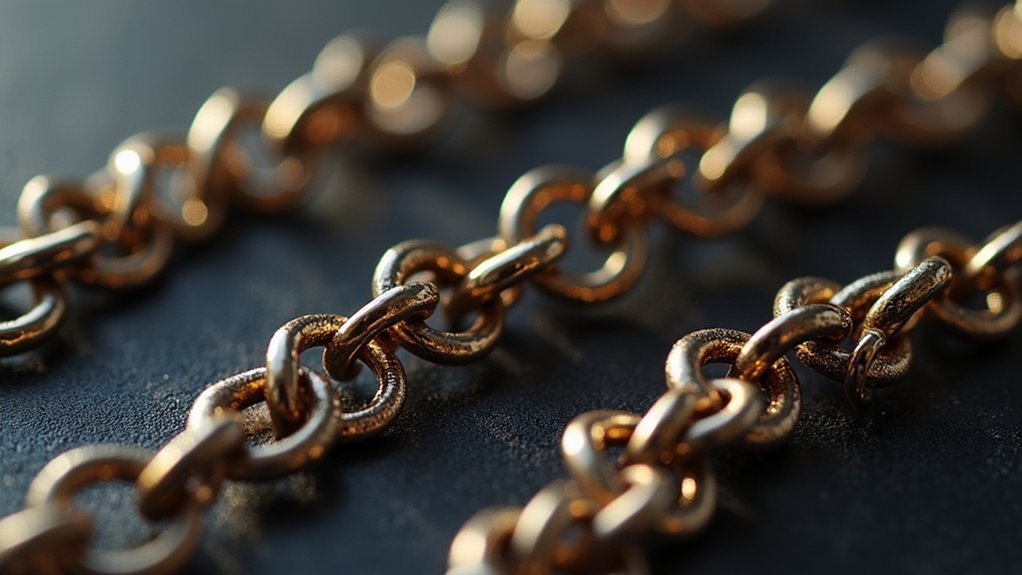
Once you’ve gathered your materials and understand the basic structure, you’ll start by creating a stable foundation with four closed rings arranged in a 2x2x2 chain formation.
Your ring placement strategy determines the Persian pattern’s success. Insert each open ring through the first two bottom rings, carefully avoiding the center rings to maintain weave integrity. The chainmaille community emphasizes consistent threading techniques – always position right-side rings over left-side rings before adding new elements.
| Step | Ring Position | Threading Path |
|---|---|---|
| 1 | Foundation | Through bottom pair |
| 2 | Right overlay | Over left rings |
| 3 | New addition | Avoid center rings |
| 4 | Closure | Maintain tension |
Speedweaving techniques can streamline your process by closing two rings before threading them onto open rings, improving efficiency while preserving pattern accuracy.
Maintaining Proper Tension Throughout the Chain
Two critical factors determine your Persian weave’s final appearance: consistent ring tension and steady hand pressure throughout the construction process.
Without proper control, your rings will shift and create unsightly gaps that compromise the weave’s integrity.
Poor tension control allows rings to migrate and form gaps that weaken the weave’s structural integrity and visual appeal.
Follow these essential steps to maintain ideal tension:
- Gently pull each ring after placement to guarantee it sits snugly against previous rings without over-tightening.
- Check tension regularly throughout construction, especially after adding multiple rings to preserve intended shape.
- Keep initial rings firmly positioned to establish a strong foundation for easier progression.
- Use pliers strategically to guide ring placement and achieve proper tension without damaging the weave.
Regular monitoring prevents distortion and guarantees your Persian chain maintains its characteristic uniform appearance from start to finish.
Speedweaving Methods for Efficient Production
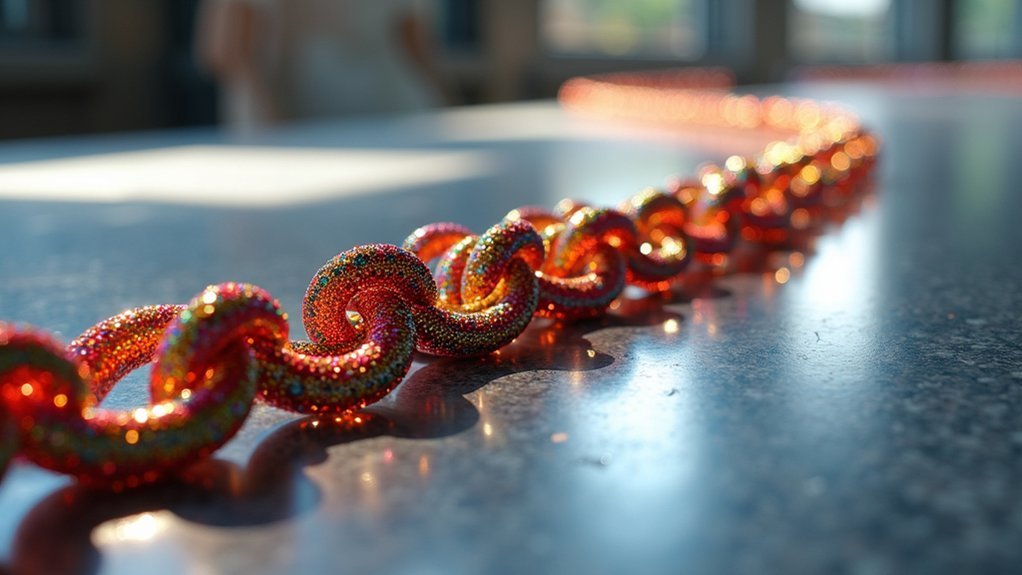
When you’re ready to accelerate your Persian chain production, speedweaving techniques can dramatically reduce assembly time while maintaining the quality standards you’ve established.
The core speedweaving method involves closing two rings simultaneously and placing them on an open ring, streamlining your link addition process. For maximum efficiency, double the number of rings you close at once, allowing quicker integration into your weave.
Maintaining consistent tension remains essential during speedweaving to guarantee uniformity and prevent loose, uneven sections. This technique proves especially valuable for larger projects where time savings compound considerably.
Consider using a jig to organize your rings and minimize constant handling. With dedicated practice, you’ll master these speedweaving techniques, making production of multiple items far more manageable and efficient.
Troubleshooting Common Weaving Mistakes
Even experienced speedweavers encounter mistakes that can compromise their Persian chain’s integrity and appearance.
When troubleshooting your weave, systematic inspection helps identify and correct errors quickly.
Common issues you’ll face include:
- Open rings – Check that each ring closes properly to prevent gaps and unraveling in your pattern.
- Inconsistent tension – Too much distorts the shape while too little creates loose, uneven sections.
- Misaligned rings – Incorrect positioning causes twisting and disrupts your overall design.
- Non-flat weave – This bumpy appearance typically indicates incorrectly added rings somewhere in your chain.
If you discover mistakes, carefully backtrack several steps to pinpoint where the error occurred.
Don’t rush the correction process – taking time now prevents larger problems later in your weave.
Finishing Techniques and End Connections
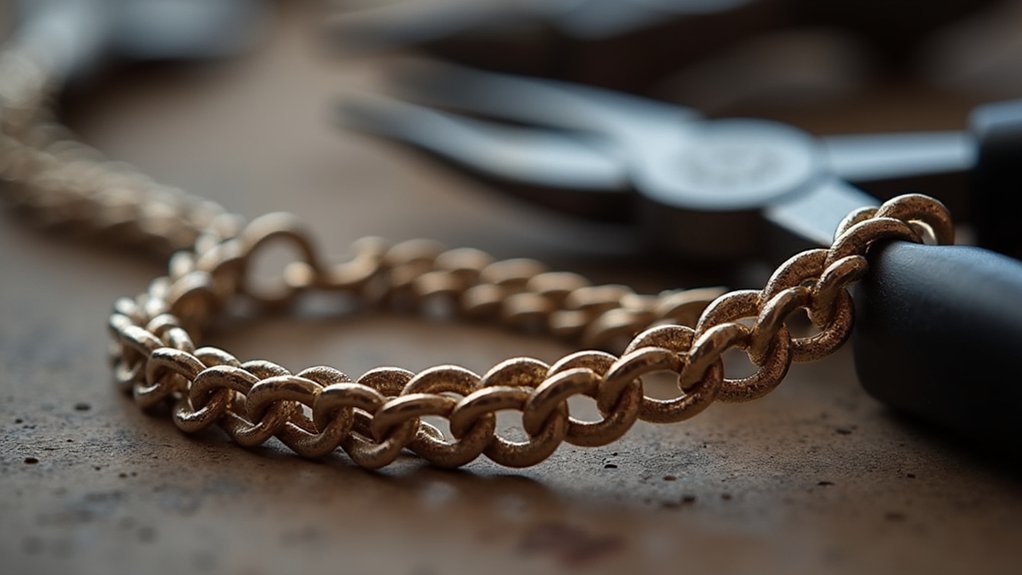
After you’ve completed the main body of your Persian chain, proper finishing techniques guarantee your weave looks professional and maintains its structural integrity.
To finish your bracelet, align both ends making sure the pattern runs in the same direction for a seamless appearance. Connect the ends using two loose rings, attaching them between corresponding rings on each side while maintaining the weave’s uniformity.
Align bracelet ends in matching directions, then connect with two loose rings between corresponding sides for seamless pattern continuity.
For clasp-free designs, add two additional rings to the connection’s sides, reinforcing the structure and preserving pattern integrity. Securely close all rings used in the connection to prevent unraveling and assure long-lasting durability.
Consider using contrasting colors for these final connections—they’ll highlight your finishing work and enhance the bracelet’s overall aesthetic appeal.
Advanced Persian Weave Variations and Applications
Mastering the basic Persian weave opens doors to more sophisticated variations that challenge your skills and expand your creative possibilities.
Advanced variations like Half Persian 4-1 and Full Persian 8-1 offer distinct aesthetic qualities with increased complexity. The Full Persian 8-1 particularly stands out with its thicker, more robust design using higher aspect ratios (AR ~5.5+), making it perfect for both armor and decorative applications.
Here are key ways to enhance your Persian weave projects:
- Experiment with contrasting materials like bronze or colored aluminum rings for visual impact
- Combine multiple Persian variations to create intricate patterns
- Integrate Persian weaves with other chainmail techniques for unique designs
- Utilize tutorials and community resources from sites like Chainmaillers.com for inspiration
This customization potential transforms functional chainmail into personalized artistic expression.
Frequently Asked Questions
How Do I Transition From Half Persian 4-1 to Other Persian Weave Variants?
You’ll modify your ring placement pattern by adjusting the weave ratio. Change from 4-1 to 3-1 for half persian three-in-one, or alter ring orientations for full persian variants. Practice changeover sections first.
What’s the Historical Origin and Cultural Significance of Persian Chainmail Weaving?
You’ll find Persian chainmail originated in ancient Persia around 300 BCE. It represented advanced metallurgy and military innovation, symbolizing protection and status. This weaving technique spread throughout medieval armies, becoming culturally significant across civilizations.
How Do I Calculate Material Costs for Large Persian Weave Projects?
You’ll multiply ring count by wire weight, then add 10-15% waste factor. Calculate wire gauge costs, tools, and finishing materials. Track diameter requirements and connector rings separately for accurate project budgeting.
Can Persian Weave Patterns Be Adapted for Jewelry-Making Applications?
You can definitely adapt persian weave patterns for jewelry by using smaller rings and precious metals. Scale down proportions, adjust ring gauges, and consider weight distribution for comfortable necklaces, bracelets, and earrings.
What’s the Difference Between European and Japanese Ring Opening Techniques?
You’ll find European technique opens rings by twisting sideways, while Japanese method pulls rings straight apart. European’s more common but stresses metal differently. Japanese preserves ring shape better, though it’s harder to master initially.
In Summary
You’ve now mastered the Persian chain weave from foundation to finish. With practice, you’ll develop muscle memory that speeds up your construction considerably. Remember to maintain consistent tension and check your aspect ratios regularly. Don’t get discouraged by initial mistakes—they’re part of the learning process. Your chainmail skills will improve with each project, and you’ll soon be creating complex patterns and exploring advanced variations with confidence.

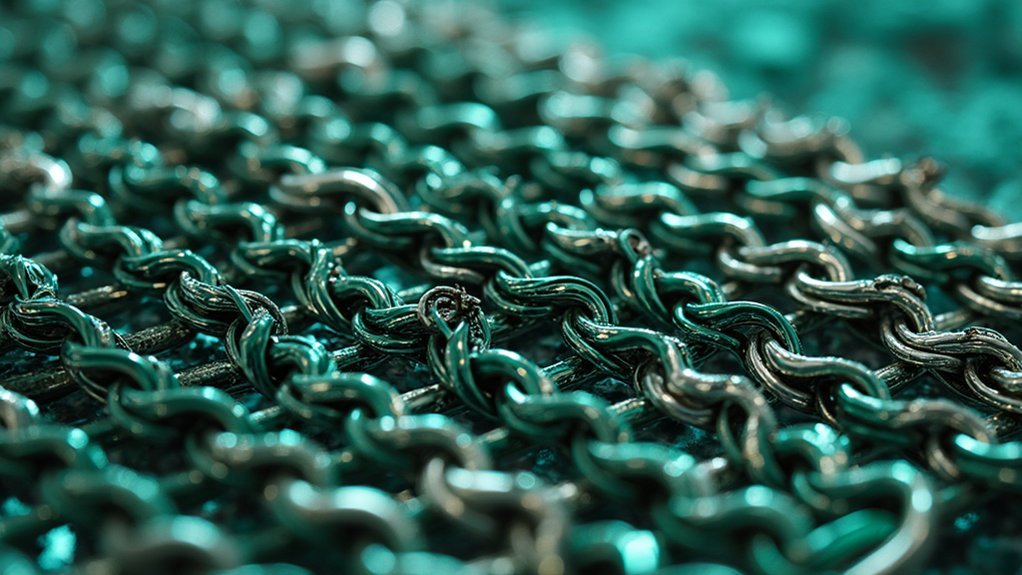



Leave a Reply